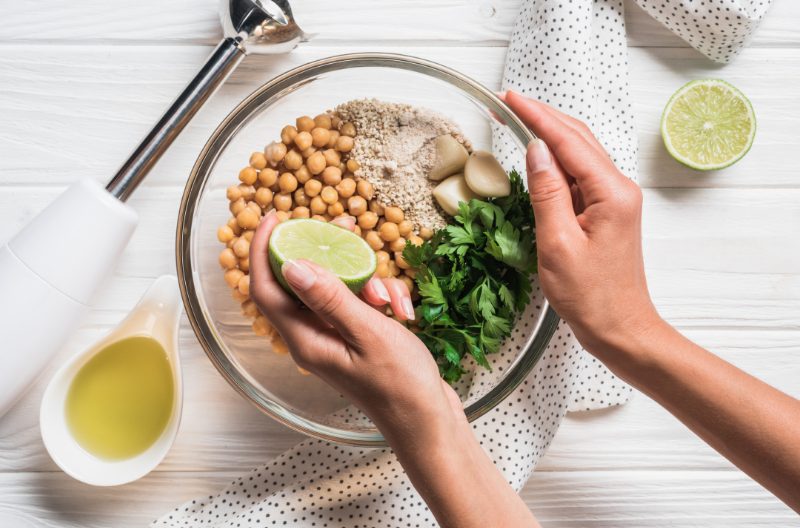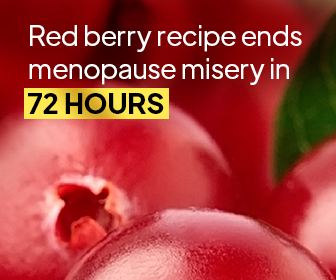Whether you’re looking to slim down a little or simply stay in shape, we all want to live well. Leading an active lifestyle is just one part of the puzzle but, in order to truly be as healthy as possible, we need to couple that with a balanced diet. Still, with so many diets out there and a wealth of conflicting information, it can be hard to determine which plans are the best for your wellness. Trying some of the top vegan diet foods could be the way to go.
In recent years, veganism has seen an astonishing surge in popularity. According to a report by Global Data, just 1% of the US population was vegan in 2014 but, last year, that percentage grew to 6%.[1] While that may seem like a low statistic, it’s important to understand that it represents a 600% increase.
So, the question on everybody’s lips has to be, why is it that so many people are turning to vegan diet foods? Here’s what you need to know.
Is a Vegan Diet Healthy?
From raw vegan diet plans to the typical vegan diet foods that have been around for years, there’s a whole array of options from which to choose. But, before you consider how to start a vegan diet for yourself, there may be yet another burning question on your mind. Is the vegan diet healthy and, if so, how does it measure up to other diet plans? Let’s take a look at the facts and explore the benefits of a vegan diet:
Prevents chronic diseases
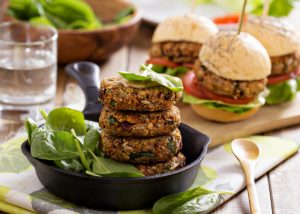
Chronic diseases such as obesity, type 2 diabetes, and certain types of cancer, are major global killers. According to the World Health Organization (WHO), these conditions are responsible for around 70% of deaths around the world.[2] With that in mind, tackling some of these conditions should be a top priority when we talk about personal health goals.
Modern medicine can help cure these illnesses, but what if we could prevent them altogether? Research from the Institute of Food Technologists (IFT) suggests that one way in which we can battle these conditions is to change our diets.[3]
The study suggests that some vegan diet foods, such as garlic, lentils, olives, pumpkin, thyme, watercress, rosemary, and artichokes, could help to prevent cancer and other chronic illnesses. Researchers concluded that a plant-based or vegan diet could be effective in warding off these conditions before they even start.
Supports weight loss
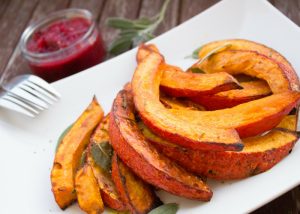
Trying to lose weight can be a difficult feat at the best of times. One of the great benefits of a vegan diet is that it can help you shed some pounds. Research from the University of South Carolina found that people lost the most weight eating solely vegan diet foods when compared to similar weight loss plans.[4]
The study found that other health benefits of a vegan diet included consuming lower levels of saturated fats, lower BMI numbers, and even higher levels of macro-nutrients. All of the above suggests that choosing to try vegan diet recipes and cutting out animal products could be a quick and healthy way to slim down.
Of course, merely switching your diet to a vegan one is not a sure-fire way to lose weight healthily and steadily. Should you be embarking on this lifestyle for that reason, you will also have to consider what vegan diet foods are healthy. Avoiding things that are high in sugars and sweeteners, for example, has to be a golden rule. You may wish to talk to a healthcare professional to help you when it comes to how to start a vegan diet.
Boosts heart health
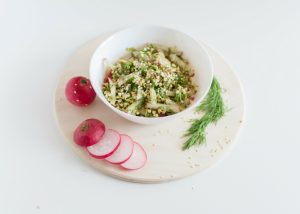
Cardiovascular disease is responsible for one in four deaths in the United States, according to the Centers for Disease Control and Prevention (CDC).[5] Each year, around 610,000 people die from conditions relating to this disease. Needless to say, keeping your heart healthy is one of the smartest ways to ensure that you lead a long and happy life.
While there’s simply no doubt that eating well and exercising regularly will keep your heart pumping healthily, you shouldn’t overlook the power of vegan diet foods. Research from St. Michael’s Hospital suggests that a low-carb vegan diet could reduce the risk of heart disease by 10% over a ten-year period.[6] The experts noted that diets high in vegetable proteins (rather than meat-based protein) can help prevent heart conditions.
How to Start a Vegan Diet
While you’ve likely heard about some of the major benefits of a vegan diet, the idea of making the change could be a little intimidating. If you’ve never looked into the area at all, you may not have a clue how to start a vegan diet. Rather than diving right into this type of lifestyle, it may help you to know some simple tips. Here are just four things that you should keep in mind if you want to follow a vegan diet for beginners:
Get to know your vegetables
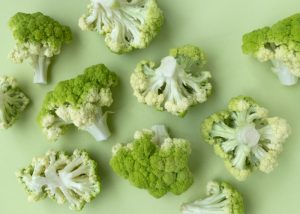
Whether you were previously a full-blown omnivore or a vegetarian, taking the steps toward a new way of eating will doubtless be a difficult feat. You may wonder how to start a vegan diet while still loving the food you eat. In many traditional western dishes, the meat takes center stage while the vegetables are seen as accompaniments or side dishes. If you’re going to start eating vegan diet foods, you need to change your perception here.
The key to getting this diet right is making the vegetables the main focus of your dish. Ingredients, such as eggplant and zucchini, can provide the main bulk of your meal. You can use these things in the place of meat. You can even season and marinate them the way that you would a fillet. Since these vegetables soak up flavor, they could make the ideal substitute for the meat in your dish.
Don’t assume “vegan” means “healthy”
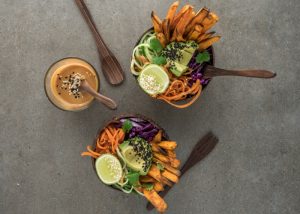
Vegan diet foods are healthy, right? Well, not always. While cutting out animal products may sound decidedly healthy, you shouldn’t make the mistake of thinking that all vegan food is good for you. Some products, like Oreos, are vegan. However, the high levels of sugar and enriched flour mean that the product is remarkably bad for you.
Simply following a vegan diet foods regime is not enough to ensure that you are eating well. According to the American College of Cardiology, while most vegan diets help lower heart disease risk, those that are high in sweets and sugars could actually increase it.[7] The researchers concluded that an emphasis should be put on the “quality” of the vegan diet foods that people choose to consume.
Focus on vegan protein sources
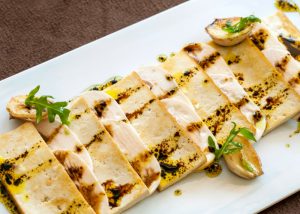
Thinking about how to start a vegan diet? One of the biggest myths you will likely hear is that vegans lack essential proteins. We all need protein to help our bodies repair muscles and maintain peak levels of health.[8] The Reference Nutrient Intake (RNI) suggests that we should consume 0.75g of protein per kilogram of our body weight per day.[9]
Of course, we all know lean meat is high in protein, and yet it might not be the healthiest source available. There are some vegan diet foods that are equally high in protein and better for your overall wellness. For instance, seitan has 25 grams of protein for every 100 grams.[10] In the same respect, tofu has around 10-19 grams of protein per 100 grams.[11]
The key to getting as much protein as you need is figuring out which vegan diet foods will offer you the highest amounts. Including these protein-rich ingredients in your meals means that you will get the balance you need.
Boost your vitamin intake
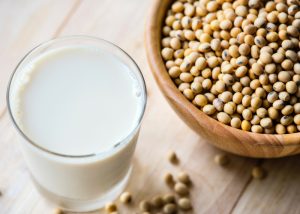
Of course, before you embark on any new eating plan, you should consider the ways in which it may affect your greater health. In order to stay as well as possible, we need a balance of essential vitamins and nutrients in our diet. Research suggests that the standard vegan diet may lack vitamin B12, iron, ferritin, calcium and vitamin D.[12]
Since all of the above are vital to your wellness, you may worry that this particular diet plan is not the right way to go. Luckily, there are ways in which you can combat this problem head-on. Boosting your vitamin intake by taking supplements is one option. You may also wish to include vegan diet foods which offer these things. For example, some plant-based milks and soy products can actually give you a shot of vitamin B12.
What Does a Raw Vegan Diet Plan Look Like?
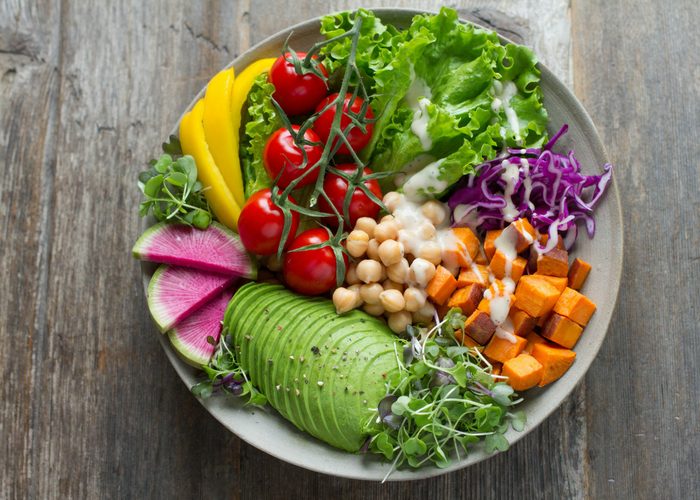
Should you wish to get the most vitamins and nutrients out of your vegan diet foods, you might want to think twice about cooking them. When you apply heat and pressure to ingredients, such as fruit and vegetables, you ultimately end up destroying some of the healthy elements. Eating raw vegan food instead means that your meals will maintain the total amount of their nutrients.
It’s not only your physical health that will benefit from a raw vegan diet plan. Interestingly enough, research from the University of Otago found that it could impact your mental well-being as well.[13] The study found that consuming fresh, raw fruits and vegetables was helped to improve people’s mental health more than canned and cooked alternatives.
Despite these facts, starting a raw vegan meal plan may be harder than it sounds. If you’ve spent your entire life eating only cooked dishes, making the complete change could be a step too far. Instead, it could be worth trying to incorporate a raw vegan diet plan into your routine once or twice a week. If you dedicate a couple of days at a time to this regime, you should find it easier to manage. Here are some tips to get you started:
Plan your meals in advance
Contrary to popular belief, making a raw vegan meal can take just as long as cooking a regular dish. Creating a raw vegan diet plan ahead of time means that you will never be at a loss for something to make. From creative salads to grain bowls, you’re sure to find a whole wealth of raw vegan meals and recipes online. Take some time to do your research.
Take things slow
When we talk about how to start a vegan diet, one of the worst mistakes people make is jumping in too fast. If you’re completely new to the raw vegan diet plan, you need to take things slow. Don’t be too hard on yourself. If you need to cook something now and then, that’s perfectly okay. Being healthy is all about enjoying your food. If you’re forcing yourself to consume meals that don’t hit the spot, you’ll never stick to the diet.
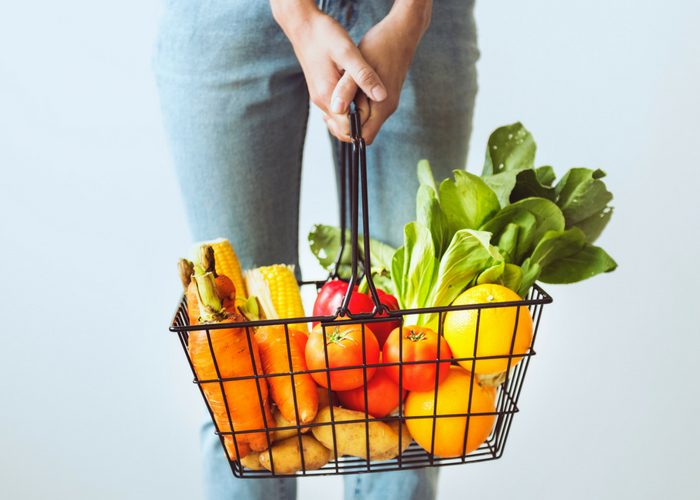
Keep things fresh
If you’re eating raw vegan meals, the last thing you want is less-than-fresh ingredients. Since you’re not cooking these products, you need to make sure that they are as ripe as possible. One way in which you can achieve this goal is by buying them on a daily basis from a local grocery store or having them delivered.
Treat yourself
You might be under the impression that a raw vegan diet plan is void of treats. Nothing could be further from the truth. Making yourself some raw vegan desserts could be a great way to keep the diet plan interesting. Believe it or not, you can actually make a raw carrot cake or raw lemon tart from scratch. Look for recipes online and get started.
7 Healthy and Satisfying Vegan Diet Foods
Do you want to embark on a vegan diet? If you’re wondering how to start a vegan diet and, more importantly, stick to it, you’ve come to the right place. It’s often easier said than done. However, the easiest way to introduce yourself to either a raw vegan diet plan or a regular one is to get to know some of the greatest vegan diet foods out there. With that in mind, here are seven of the healthiest and most satisfying ingredients to try:
1. Tofu
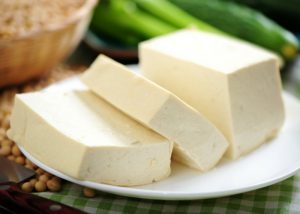
Tofu has been at the heart of vegan diet foods for many years now, but do you know what it is? This ingredient is actually made from pressing soybean curds. That’s what gives it the unmistakable thick and sturdy texture. What’s more, there are many underlying health benefits of vegan diet staples like tofu.
As we’ve already covered, this ingredient can offer vitamin B12, which is a vitamin that many vegans tend to lack. However, that’s not all that tofu boasts. The ingredient is rich in both iron and calcium, which are essential parts of a balanced diet.[14] Plus, it’s low in fat so you don’t have to worry too much when it comes to keeping the portion size low.
If you’ve never cooked tofu before, you might not know where to start. There’s no doubt that tofu is a plain food. It doesn’t have much flavor. That’s why you need to take extra care when cooking vegan diet recipes with it. When you get unpressed tofu, you will need to press it at home to get rid of any excess moisture. You can then marinate it in herbs, spices, and other flavorings before grilling or baking it.
2. Legumes
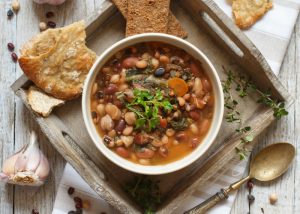
Chickpeas, peas, beans, and lentils – legumes are the dietary staple that everybody should know about. When you’re eating vegan diet foods each day, you should be including some of these ingredients in most of your meals. The main reason these are so popular is because they can easily replace major animal products, such as meat, eggs, and fish, in vegan diet recipes.
Aside from being rich in fiber, zinc, and antioxidants, these vegan diet foods could offer some more surprising health benefits. One study published in the JAMA and Archives Journals found that eating more of these ingredients could help to lower the risk of heart disease and help people control their glycemic levels.[15]
Some of the most popular vegan diet recipes you will find online have legumes as their base. For example, you can easily make a vegan curry, chili, or stew using these ingredients to bulk it out. If you’re used to cooking with ground meat or even chunks of meat, simply swap this ingredient for lentils or beans. The results may just surprise you.
3. Leafy greens
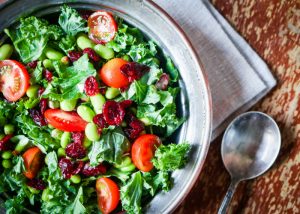
Do you eat your greens? When considering how to start a vegan diet, increasing the amount of leafy greens you eat on a daily basis is one way in which you can stay healthy. Ingredients such as spinach, kale, and collards, are affordable and good for you.
Research from the Federation of American Societies for Experimental Biology (FASEB) suggests that eating leafy greens can help boost cognitive functions.[16] The results of the study state that since these vegan diet foods are rich in vitamin K, they could have some notable mental benefits. One of the most surprising, perhaps, is their ability to help ward off the signs of aging when it comes to the brain and keep you sharper for longer.
There has also been evidence to suggest that eating leafy greens on a regular basis could reduce the risk of diabetes. One study published in the British Medical Journal found that eating just one and a half extra servings of leafy greens per day could reduce a person’s chances of developing type 2 diabetes by around 14%.[17]
Luckily, many vegan diet recipes include leafy greens as one of the main ingredients. Dishes such as superfood salads and stews often contain these products in large proportions. Plus, ingredients such as spinach and kale make great raw vegan food. You don’t need to cook them, which means that they retain all their vitamins and nutrients.
4. Hemp seed
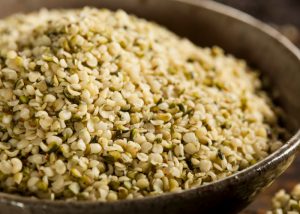
Need a little something to sprinkle on top of your salad? How about an extra vegan food ingredient to make your smoothie extra special? Hemp seed could be it. While you may not have heard much about this particular raw vegan food, it’s worth looking into the benefits that it could offer you.
There’s research to suggest that hemp seed is high in omega-3, which is one of the essential nutrients that vegans may miss out on. As a bonus, in terms of plant-based protein, you won’t find a much better seed. Around 28 grams (1 ounce) of these seeds contain 9 grams of protein.[18] That is around half the times more than most seeds contain, meaning that you get a whole load of nutrition from these small, yet mighty ingredients.
While there’s little chance that hemp seed will be the foundation of vegan diet recipes, you can add them to virtually any type of dish. Whether you’re making a bowl of grains or even having dessert, including these could give your food added goodness.
5. Plant-based milk
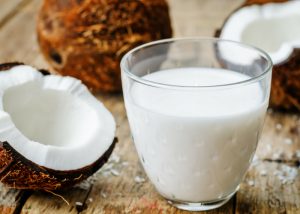
Without a shadow of a doubt, one of the things people find the most difficult when it comes to cutting out animal products is milk. Whether you drink it in your morning coffee or pour it on your cereal, the idea of giving up this ingredient completely could be difficult. Thankfully, there’s a whole host of plant-based milk alternatives on the market.
It’s no great wonder that the sale of these vegan diet foods more than doubled between 2009 and 2015.[19] From oat milk to coconut milk, there are many different types of alternatives that you can try. Which you choose will depend on your personal taste and preferences – it could be worth trying a range of choices.
If you’re looking for an option that ticks all the nutritional boxes, opting for soy milk could be the way to go. Research from McGill University suggests that not only is this the most nutritionally balanced of the current alternatives on the market but it is also one of the highest in protein.[20] However, it’s worth noting that some people find the bean-like taste too strong.
6. Avocado
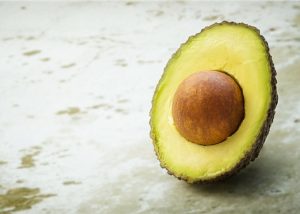
It’s not merely a food fad – avocado is a fantastic raw vegan food. The fruit (yes, it’s a fruit – not a vegetable!) is nutrient-rich and low in fat, which makes it the perfect vegan diet foods ingredient. Avocados are high in vitamins A, D, K and E as well as offering healthy fats that our bodies need.[21]
Looking for a way to mix up your vegan diet recipes? Adding a rich yet nutritious avocado salad dressing to your repertoire could be the answer. In fact, there are loads of vegan diet recipes that include this particular fruit. It’s also worth noting that you can use avocado as a staple of a standard raw vegan diet plan as well.
Whether you chop it up and put it on toast, make a delicious homemade guacamole from it, or enjoy it straight from the fridge, there are so many ways to include this food in your diet. If you’ve not tried it for yourself, now could be a great time to experiment.
7. Nuts
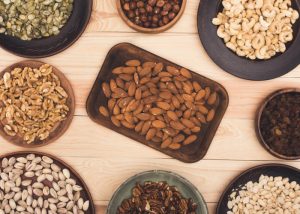
When hunger strikes, it’s all too easy to reach for a bag of chips or, worse, some chocolate. However, while you may not realize it, there are loads of healthy vegan diet foods that you can eat instead. One of the most satisfying plant-based snacks out there has to be the humble nut. Packed with protein and antioxidants, these ingredients are ones that you shouldn’t overlook when it comes to looking after your health.
Aside from the essentials that these snacks offer, they could be just the thing to keep your heart healthy. According to research from the American College of Cardiology, regular nut consumption can lead to a lower overall risk of heart disease.[22] That means that choosing to eat these as a snack each week could have some striking benefits in terms of your cardiovascular health in the long-term.
However, you should note that, while nuts are full of healthy fats, over-indulging in them could lead to weight gain. For the best health benefits, you should consume these snacks in small portions on an infrequent basis. Eating them now and then when you need a little pick-me-up is the smartest way to go.
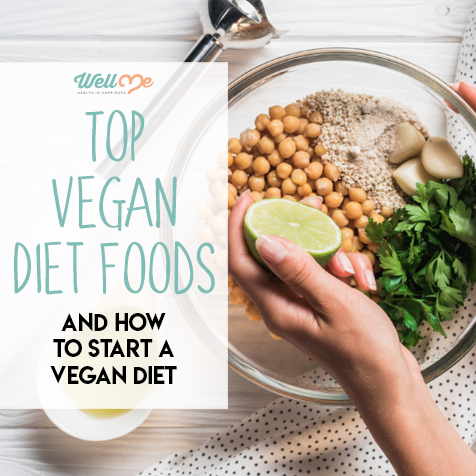
Conclusion
Now that you know how to start a vegan diet along with some of the top vegan diet foods, what are you waiting for? Changing your eating plan and trying something completely new may feel a little intimidating at first. It’s a real challenge. Despite this, you will never know if you can stick to a raw vegan diet plan or a plant-based diet until you try it for yourself.
As we’ve learned here, there’s a massively wide range of science-backed health benefits of a vegan diet. Perhaps that’s why so many people are now trying it. Why not start small and try cooking some vegan diet foods at home today? You might just find that it’s a smart move for your health. Give it a go!
References
- [1] https://www.reportbuyer.com/product/4959853/top-trends-in-prepared-foods-2017-exploring-trends-in-meat-fish-and-seafood-pasta-noodles-and-rice-prepared-meals-savory-deli-food-soup-and-meat-substitutes.html
- [2] http://www.who.int/ncds/en
- [3] http://www.newswise.com/articles/plant-based-diets-can-remedy-chronic-diseases
- [4] https://linkinghub.elsevier.com/retrieve/pii/S0899900714004237
- [5] https://www.cdc.gov/heartdisease/facts.htm
- [6] http://www.stmichaelshospital.com/media/detail.php?source=hospital_news/2014/20140522_hn
- [7] https://www.sciencedirect.com/science/article/pii/S0735109717375216?via%3Dihub
- [8] https://www.nutrition.org.uk/nutritionscience/nutrients-food-and-ingredients/protein.html
- [9] https://www.nutrition.org.uk/nutritionscience/nutrients-food-and-ingredients/protein.html
- [10] https://nutritiondata.self.com/facts/cereal-grains-and-pasta/7738/1
- [11] https://nutritiondata.self.com/facts/legumes-and-legume-products/4381/2
- [12] http://jaoa.org/article.aspx?articleid=2488034
- [13] https://www.frontiersin.org/articles/10.3389/fpsyg.2018.00487/full
- [14] https://nutritiondata.self.com/facts/legumes-and-legume-products/4467/2
- [15] https://media.jamanetwork.com/news-item/eating-more-legumes-may-improve-glycemic-control-lower-estimated-heart-disease-risk/
- [16] http://www.newswise.com/articles/eating-green-leafy-vegetables-keeps-mental-abilities-sharp
- [17] https://www.sciencedaily.com/releases/2010/08/100819214607.htm
- [18] https://nutritiondata.self.com/facts/custom/1352377/1
- [19] https://med.virginia.edu/ginutrition/wp-content/uploads/sites/199/2014/06/January-18-Milk-Alternatives.pdf
- [20] https://www.mcgill.ca/newsroom/fr/node/32895
- [21] https://www.californiaavocado.com/nutrition/nutrients
- [22] https://www.sciencedirect.com/science/article/pii/S0735109717398224?via%3Dihub

